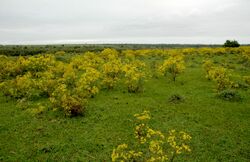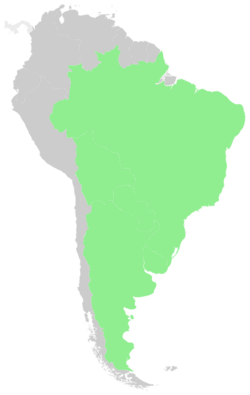Biology:Senecio brasiliensis
| Senecio brasiliensis | |
|---|---|

| |
| flor-das-almas growing in Rio Grande do Sul | |
| Scientific classification | |
| Kingdom: | Plantae |
| Clade: | Tracheophytes |
| Clade: | Angiosperms |
| Clade: | Eudicots |
| Clade: | Asterids |
| Order: | Asterales |
| Family: | Asteraceae |
| Genus: | Senecio |
| Species: | S. brasiliensis
|
| Binomial name | |
| Senecio brasiliensis (Spreng.) Less.
| |

| |
| Native range of S. brasiliensis. | |
| Synonyms | |
|
Cineraria brasiliensis Spreng.[1] | |
Senecio brasiliensis, known by the common name flor-das-almas,[1] (flower-of-souls), is a perennial species of the genus Senecio and family Asteraceae. It is native to fields and meadows of central South America.
Description
S. brasiliensis is a densely leafy perennial herb, 1 metre (3.3 ft) to 2 metres (6.6 ft) tall, with yellow flowers that prefers to make its home in degraded pasture lands and unploughed croplands in central South America.[3][4]
Leaves and stems: S. brasiliensis stands very upright with a branched hairless and grooved stem. The leaves are alternate, pinnate and deeply lobed[4] dark green on the top, whitish green on the underside.[5] The lower part of the plant is smooth, while the upper part is hairy and the leaves cluster at the highest point with the flower stalks (corymbs).[4]
Flowers: Yellow flowers dense on corymbs; two types of flowers (that look like [petal]s), disc florets with both male and female flowers and ray flowers which are simply female.[4]
Seeds: Small seed with white hairs that use the wind to get around with.[4]
Common Names
- English: Flower of souls, hempleaf ragwort
- Portuguese: malmequer-amarelo, Maria-mole, tasneirinha, flor-das-almas[1][4][5][6]
- Guarani: Agosto poty (August flower)
Distribution
S. brasiliensis grows at elevations of 0 metres (0 ft) to 1,000 metres (3,300 ft).
Native: Argentina (mostly North Argentine Northwest and Gran Chaco), Bolivia, Brazil (mostly South Central), Paraguay, and Uruguay.[1][2][4][6]
Current:
- America
- Europe
- South-West Europe: Portugal[7]
Predators
- Phaedon confinis (Chrysomelidae)[3]
- Atarsocoris brachiariae (Hemiptera: Cydnidae) – Burrowing brown bug[8]
References
- ↑ 1.0 1.1 1.2 1.3 {{citation | mode = cs1 | title = Senecio brasiliensis | work = Germplasm Resources Information Network (GRIN) | url = | publisher = [[Organization:Agricultural Research ServAgricultural Research Service (ARS), United States Department of Agriculture (USDA) | access-date = 5 March 2008 }}
- ↑ 2.0 2.1 Instituto Darwinion. "Asteraceae" (in Spanish) (PDF). Catálogo de las Plantas Vasculares de la República Argentina. II. Universidad de Buenos Aires. pp. 184, 188. http://www.darwin.edu.ar/Publicaciones/CatalogoVascII/CatalogoVascII.asp.
- ↑ 3.0 3.1 "ENTOMOFAUNA ASSOCIATED WITH SENECIO BRASILIENSIS LESS (ASTERACEAE), AND PHAEDON CONFINIS (INSECTA; COLEOPTERA; CHRYSOMELIDAE) AS A POSSIBLE CONTROLLER AGENT OF THIS TOXIC PLANT" (in pt). 2005-04-20. http://www.uepg.br/propesp/publicatio/exa/2005_3/06.pdf. "Phaedon confinis Klug, 1829 (Chrysomelidae) was the one that most stood out, specially because it was found in great numbers on the plant"
- ↑ 4.0 4.1 4.2 4.3 4.4 4.5 4.6 "Senecio spp." (in pt). Lista de Plantas. Universidade Federal de Santa Maria. March 2001. http://www.vet.uga.edu/VPP/NSEP/toxic_plants/POR/Senecio/index.htm.
- ↑ 5.0 5.1 Centro de Informação Toxicológica do Rio Grande do Sul. "Senecio brasiliensis Less. – Maria-mole" (in pt). http://www.cit.rs.gov.br/v2/nova/?p=p_126.
- ↑ 6.0 6.1 6.2 Natural Resources Conservation Service (NRCS). "PLANTS Profile, Senecio cannabinifolius Hook. & Arn.". The PLANTS Database. United States Department of Agriculture. http://plants.usda.gov/index.html.
- ↑ Dana, E. D., Verloove, F., Alves, P., & Heiden, G. (2021). Senecio brasiliensis (Spreng.) Less. (Asteraceae), another potentially invasive alien species in Europe. BioInvasions Records, v. 10 (3), 521-53
- ↑ Oliveira Émerson D.M. de, Pasini Amarildo, Fonseca Inês C.B., ÉMerson D.M. de; Pasini, Amarildo; Fonseca, Inês C.B. (January 2003). "Association of the soil bug Atarsocoris sp. (Hemiptera: Cydnidae) with the weed Senecio brasiliensis Less". Neotropical Entomology (Sociedade Entomológica do Brasil) 32 (1): 155–157. doi:10.1590/S1519-566X2003000100024. 1519566X.
External links
- "Senecio cannabinifolius". Integrated Taxonomic Information System. https://www.itis.gov/servlet/SingleRpt/SingleRpt?search_topic=TSN&search_value=36108. Retrieved 6 March 2008.
- "Herbarium record". Neotropical Herbarium Specimens. fieldmuseum.org. http://fm1.fieldmuseum.org/vrrc/?page=view&id=7247.
- Gustavo H. Shimizu (2006-09-30). "Image of Senecio brasiliensis". http://www.plantsystematics.org/cgi-bin/dol/dol_image_frame.pl?image_id=27016&image_file=http://www.PlantSystematics.org/users/sv22/1_31_07/Senecio_brasiliensis.jpg&family=Asteraceae&genus=Senecio&species=brasiliensis.
Wikidata ☰ Q5675023 entry
 |


